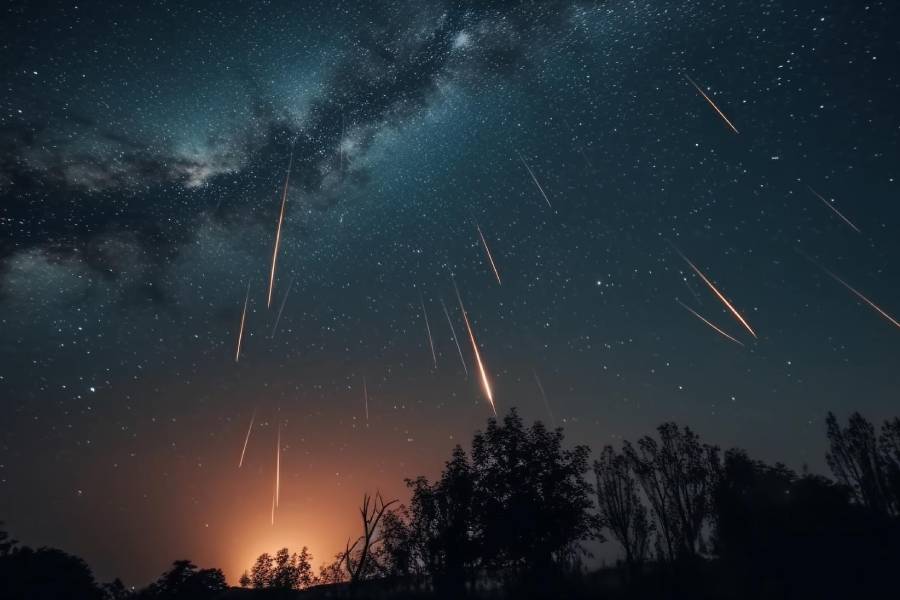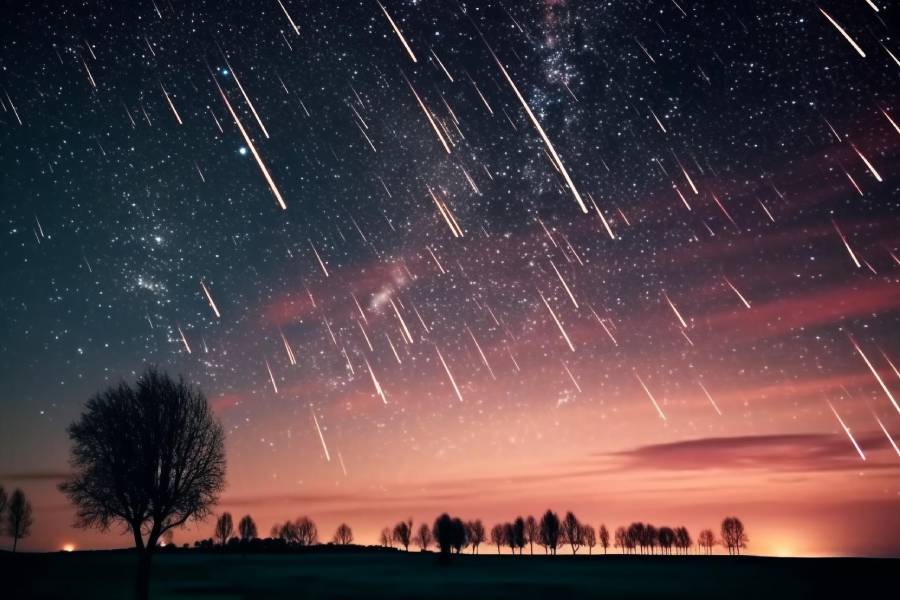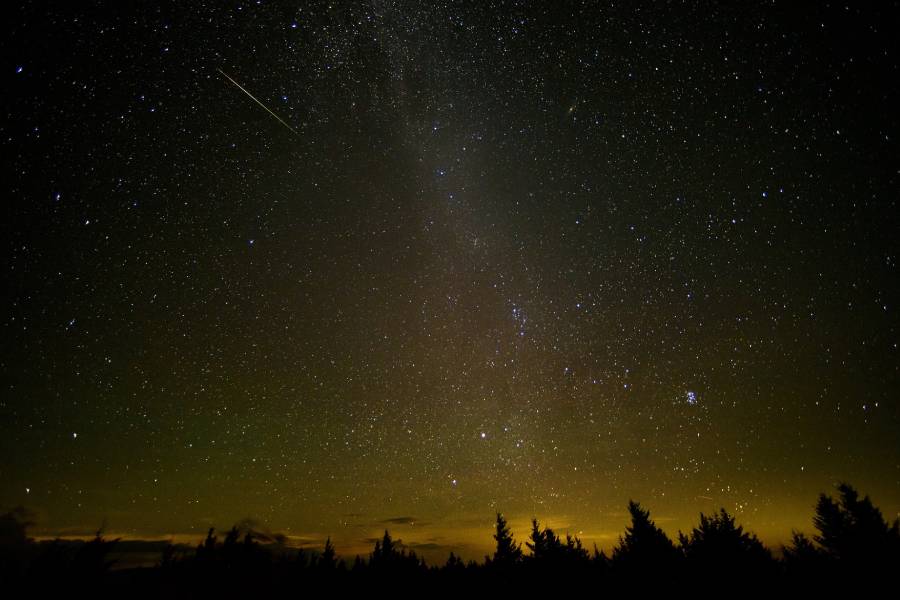Ever see a streak of light flash by in the night sky? These brief bursts are meteors and meteor showers produce epic celestial displays. But what are meteor showers? What do meteor showers look like?
This article will explain everything about meteor showers. We’ll explore them, what causes showers, major annual showers to watch for, and provide viewing tips. Continue reading to learn the science behind these spectacles and how to spot shooting stars in your night sky.
What Are Meteor Showers?
Meteor showers involve a heightened number of shooting stars visible in the night sky when Earth passes through debris left by comets or asteroids. These tiny particles burn up in Earth’s atmosphere, creating bright streaks of light known as meteors.
The debris comes from comets, releasing a mix of ice, dust, and rocky material along their orbits when heated by the Sun. Earth intersects these comet orbits at specific times each year, leading to predictable meteor shower events.
Also, the intensity of meteor showers can vary; some produce only a few meteors per hour, while others display dozens or even hundreds. To witness these cosmic events, optimal viewing conditions involve being away from city lights during the peak times of the shower. This attracts amateur astronomers and stargazers to observe the celestial spectacle.

Meteors and Their Origins
Meteors are particles of dust and debris from space. They burn up upon entering Earth’s atmosphere, a process that typically occurs 50-75 miles above the planet’s surface.
Furthermore, most meteors originate from comets. As comets orbit the Sun, they shed dust and rocks, forming debris trails along their path.
So, when Earth’s orbit intersects these trails, the particles collide with our atmosphere at high speeds. The resulting compression heats them up, creating the streaks of light we call meteors.
Difference between meteors, meteoroids, and meteorites
There are differences between meteors, meteoroids, and meteorites. Meteoroids are particles of debris orbiting the Sun. They become meteors upon entering Earth’s atmosphere. Meteors are what we see when meteoroids burn up as flashes of light in the sky.
On the other hand, meteorites are larger objects. They survive the fall through the atmosphere and reach Earth’s surface as rocks from space. Discovering and studying meteorites is a crucial aspect of planetary science, as they offer valuable insights into the early solar system.
Overview of the annual meteor shower calendar
Annually, several major meteor showers capture the fascination of skygazers. Notable among these are the Quadrantids in early January, the Lyrids in late April, the Perseids in mid-August, and the Geminids in mid-December.
The peak of activity occurs when Earth traverses the densest part of a meteoroid stream, resulting in meteor shower peaks that typically last a day or two. These celestial events offer a breathtaking spectacle, providing millions worldwide with an opportunity for fantastic night sky viewing. With peak rates reaching up to 100 meteors per hour, these showers are truly mesmerizing celestial phenomena.
Meteoroids and Debris Trails
Origin and composition
Meteoroids originate within our Solar System, with the majority originating from either comets or asteroids. Comprising dust, ice, and rocky particles, these meteoroids acquire their material from the tail and nucleus of comets, as well as from asteroid collisions.
In terms of size, meteoroids exhibit significant variation, ranging from tiny specks to sand-sized particles. Furthermore, their composition and density can vary substantially, contingent upon the specific source object from which they originated.
Trails of debris
As comets gracefully orbit the Sun, they leave trails of debris in their wake. The heat causes their icy nuclei to sublimate, releasing a delicate dance of dust and gases. These ethereal formations create long, hazy trails that follow the comet’s celestial path.
Similarly, asteroid collisions generate trails of rocky debris in the vastness of space. While these trails disperse slowly over time, their persistence can extend for thousands of years.
These enduring debris trails serve as expansive reservoirs of meteoroid particles in orbit around the Sun. Over the millennia, they became the timeless building blocks for meteor showers, contributing to the celestial spectacle that graces our night skies.
Meteor Shower Formation
Earth’s passage through debris fields
Meteor showers occur when Earth passes through trails of debris left by comets or asteroids. For instance, the Perseid meteors trace their origin to Comet Swift-Tuttle, while other showers align with known comets like Halley’s Comet and Comet Encke.
By studying the parent bodies of meteor showers, we gain valuable insights into comets. These trails act as reservoirs, enabling streams of meteoroids to intersect Earth’s orbit at specific points, triggering intense meteor activity.
Gravitational influences on meteoroid trajectories
Planetary gravity gradually pulls debris trails closer to Earth’s orbit. Notably, Jupiter’s gravity redirects meteoroid streams to intersect Earth’s path. Gravitational focusing just before meteor showers results in higher meteoroid densities.
As peak activity approaches, more particles converge in Earth’s direction. This focusing effect significantly amplifies the meteor rate, contributing to the creation of spectacular meteor displays during showers.
Conditions favoring a more significant meteor shower display
Peak meteor shower activity depends on high meteoroid density in space. When Earth crosses close to a comet’s nucleus, it produces significant trails. Faster-moving meteoroids also favor high rates.
Additionally, darkness, clear skies, and no moonlight improve viewing conditions on Earth. Annual meteor showers occur as Earth’s orbit intersects the same debris trails. Activity is higher during peak crossing points.

Notable Meteor Showers
Overview of well-known annual meteor showers
Every year, a handful of dependable meteor showers grace the night sky. As mentioned, among the most eagerly anticipated are the Perseids, Geminids, Quadrantids, Orionids, and Taurids.
In August, the Perseids steal the show, offering a breathtaking display of up to 100 meteors per hour at their peak. As December arrives, the Geminids take center stage, boasting a mesmerizing spectacle of over 150 meteors per hour. While some showers present lower rates, their celestial performances remain nothing short of impressive.
Characteristics and peak times for various meteor showers
Every meteor shower boasts unique characteristics. The Perseids are known for leaving persistent trails, while the Quadrantids dazzle with bright fireballs, and the Taurids showcase very high-altitude meteors.
In addition, peak activity typically spans a day or two for most showers. The Perseids reach their climax on August 12th and the Geminids peak around December 14th. Understanding the peak times of each shower enables optimal viewing planning.
Historical records of notable meteor shower events
Throughout the centuries, exceptional meteor storms have left their mark on the night sky. In the 1800s, the Leonids dazzled with meteor ‘storms,’ boasting thousands per hour. Fast forward to 1966, and the Leonids continued to captivate observers, unleashing a prolific display that peaked at a remarkable 40 meteors per second.
These historic outbursts provide a glimpse into the ever-changing nature of meteor shower activity over time. Thanks to contemporary observations, we can better predict and anticipate future enhanced displays.
Observing Meteor Showers
Best times and locations for meteor shower observation
It’s best to observe meteor showers when the radiant is highest in the sky, usually after midnight. Finding a viewing spot away from city lights is ideal for dark skies.
Also, watching during peak activity yields the highest rates. Plus, moonless nights are preferred to allow fainter meteors to be visible.
Tips for optimal meteor watching
No special equipment is necessary; all that’s required are one’s eyes. Recline to scan the skies instead of relying on telescopes. Allow a moment for the eyes to adjust to the darkness. Simply relax and observe for streaks of light.
The inclusion of warm clothing and reclining chairs enhances comfort for prolonged observing sessions during shower peaks. Moreover, meteors have the potential to appear anywhere, prompting an attentive gaze toward the entire expanse of the sky.
Tools and technologies for meteor shower photography
Long-exposure photography skillfully captures meteors as radiant streaks against landscapes. Secure cameras on stable tripods and utilize a high ISO to enhance light exposure.
Furthermore, advanced image processing software seamlessly merges multiple exposures over time, producing a composite image that unveils numerous meteors in a single frame. Additionally, video cameras are adept at recording meteor activity, especially during celestial showers.

Conclusion
What are meteor showers? Meteor showers unfold when Earth traverses debris trails left by comets and asteroids. The planet’s orbit around the Sun guides it through concentrated streams of meteoroids that illuminate our night sky.
These captivating events have captivated generations of skywatchers and scientists across centuries. With an understanding of meteor origins, the formation of showers, major annual showcases, and optimal observing practices, enthusiasts can anticipate these dazzling displays at their yearly peaks.
Altogether, we aimed to enhance the reader’s appreciation for these extraordinary nocturnal
